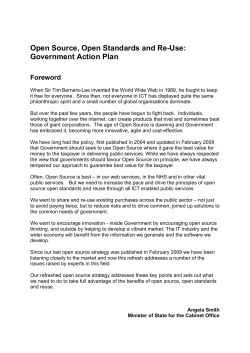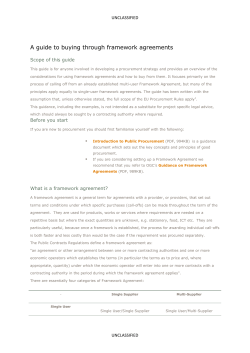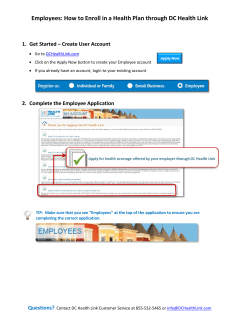
Treatment providers: playing a vital role in injury management
Treatment providers: playing a vital role in injury management A presentation covering the 2012 legislative reforms, the certificate of capacity and other critical topics. Dr. Roland Loeve, Injury Management Consultant Maria Wilson, Claims Design Officer Medical & Allied Health Team WorkCover NSW WorkCover Authority NSW Unclassified Safety, Return to Work and Support Division 1 Agenda • • • • • • • • • • Intent of the legislative reforms Exempt claimants Key reforms: o Weekly payments and benefits o medical and related expenses o Prior approval exemptions o Work capacity o Permanent Impairment Recovery at work Health benefits of work Certificate of capacity Communication Case conferencing Allied health provider framework review Case Studies Unclassified 2 Intent of the legislative reforms The reforms are designed to: • Encourage and assist workers to stay at work, to recover or return to work as early and safely as possible. • Provide better financial support for seriously injured workers. • Return the scheme to financial sustainability without increasing employer premiums. Unclassified 3 Exempt claimants Some claimants are exempt from all the 2012 reforms: • Police officers • Paramedics • Firefighters • Coal miners • Workers who make a dust diseases claim • Emergency services volunteers Unclassified 4 Key reforms: weekly payments and benefits Medical and related expenses • Except for seriously injured workers: o Medical and related expenses are time limited to 12 months from when the worker ceases to be entitled to weekly payments. o If the injured worker has not received any weekly payments, medical and related expenses are time limited to 12 months after the claim was made • WorkCover has additional powers to determine who can provide services. • Most treatment will require prior approval. Unclassified 5 Key changes for doctors: prior approval exemptions • Nominated treating doctor consultations (apart from mental health consultations) to facilitate early access to treatment. • The first consultation for the injury with a specialist medical practitioner, on referral by the worker’s nominated treating doctor. • Pharmacy items prescribed by the medical practitioner for the injury in the first 3 weeks post injury, to a maximum of $500 and items excluded from the PBS to a maximum amount of $100. • All plain x-rays performed on referral from the nominated treating doctor or specialist medical practitioner in relation to the injury claimed and provided within one week of injury. • Any services provided in public hospitals that are provided by or consequent upon presentation at the hospital’s emergency department for the injury claimed that are within one month of the date of injury. Unclassified 6 Key changes for allied health providers: prior approval exemptions • Allied health treatment provider approval exemptions essentially unchanged • Incidental expenses not exempt – unintentional omission – Hope to address next edition Claims Compensation Benefits Guidelines • Treatment outside of exemptions must be approved via submission of management plan – If no management plan submitted and approved, then employer not liable (and therefore insurer won’t pay) Unclassified 7 Key reforms: work capacity Work capacity is the worker’s capacity to recover at work in suitable employment (not just pre-injury employment) Unclassified 8 Key reforms: work capacity (cont.) Work capacity assessment and decisions - what it is: • Ongoing process of assessment/re-assessment throughout claim • Multidisciplinary and evidence-based process - communication vital • Review of the worker’s functional, vocational and medical status to: • o determine capacity for work, and o determine entitlement to weekly payments Decisions are binding, but are subject to a legislative review process if an application for review is made. Unclassified 9 Key reforms: permanent impairment Except for exempt workers: • Lump sum compensation for permanent impairment is only payable when a worker is assessed as having more than 10% permanent impairment for physical injuries (including hearing loss). • Section 67 lump sum payments for pain and suffering was repealed. Unclassified 10 Focus on recovery at work • The reforms are focused on encouraging and assisting workers to remain at work while they recover or return to work as soon as possible. • Early return to work (or staying at work) is good for: o NSW workers, with quick, safe and durable return to work shown to be good for the worker’s recovery, health and wellbeing. o NSW employers, getting skilled workers back in the workplace faster, and reducing the costs of claims and related premium adjustments. o The NSW economy, with more workers working, and less strain on the workers compensation scheme. Unclassified 11 Unclassified 12 Health benefits of work • The AFOEM position statement ‘Realising the Health Benefits of Work’ - 20 days of work the chance of ever getting back to work is 70% - 45 days off work the chance of ever getting back to work is 50% - 70 days off work the chance of ever getting back to work is 35% • Work, in general, is good for health and wellbeing; and • Long term work absence work disability and unemployment have, in general, a negative impact on health and wellbeing. 1. Johnson D, Fry T. Factors Affcting Return to Work after Injury; A study for the Victorian WorkCover Authority. Melbourne; Melbourne institute of Applied Economics and Social Research; 2002 Unclassified 13 Health benefits of work (cont.) • Work practices, workplace culture, work-life balance, injury management programs and relationships within workplaces are key determinates, not only of whether people feel valued and supported in their work roles, but also of individual health, wellbeing and productivity. • Health professionals exert a significant influence on work absence and work disability, particularly in relation to medical sickness certification practices. This influence provides health professionals with many opportunities for patient advocacy, which includes, but is not limited to, recognition of the health benefits of work. Unclassified 14 Certificate of capacity The WorkCover certificate of capacity: • Has been developed to shift the focus to what the worker can do rather than what they can’t do. • Asks doctors to consider the capacity for all activities of daily living when determining the worker’s capacity. • Supports proactive management – 28 day timeframe. • Supports case managers to provide good case management – guides injury management and return to work planning. Is considered: • along with other evidence, by the insurer in assessing the workers capacity for work. • when addressing issues that lead to a case conference or involvement of an independent medical consultant. Unclassified 15 Certificate of capacity Unclassified 16 Communication The return to work process involves communication and collaboration between a multidisciplinary team of individuals who together provide a support team for the worker with an injury. Each has a particular role, area of responsibility and expertise. Communication and collaboration is essential to: • Gain understanding of the worker’s capacity, needs and develop shared goals and recovery expectations • Identify any barriers or risks to recovery and effective strategies to address these issues • Ensure the workers receive consistent messages from team members • Ensure the right service is provided at the right time. Key element in successful return to suitable employment is effective communication. Unclassified 17 Support team • Nominated treating doctor • Employer • Insurer • Other treating health professionals (e.g. physiotherapist, psychologist etc.) • Workplace rehabilitation provider Unclassified 18 Billing • Fees Orders sets the maximum for which an employer is liable under the Act for treatment of an injured worker’s work-related injury. • Treatment and/or services may consist of: – Issuing certificate of capacity (only to be charged once per claim) – Consultation (fee based on complexity, not time) – Providing medical records (in line with Privacy Amendment (Enhancing Privacy Protection) Act 2012) – Communication regarding return to work Unclassified 19 Communicating is billable Workers Compensation (Medical Practitioner Fees) Order 2014 Various allied health Fees Orders: e.g. – Workers Compensation (Physiotherapy Fees) Order Workers Compensation (Psychology Fees) Order For GP’s, these rates may cover: • case conferences • visits to worksites • time spent reviewing injury management or return to work plans and, • additional reports requested from treating doctors. These services should be billed under the WorkCover payment classification code WCO002 for GP’s and reflect the time taken (to the nearest 5 minutes) to deliver the service. Unclassified 20 Case conferencing • Face-to-face meeting or teleconference with any or all of the multidisciplinary team involved in assisting the worker to recover at work for the purpose of return to work planning. • May be held at the conclusion of a workers consultation with a nominated treating doctor, who must document discussion and agreed outcomes in the workers case notes. Unclassified 21 Billing The following is not permitted in NSW workers compensation system: • Request for pre payment for services. • Invoicing above the gazetted fee. It is preferable that payment not be obtained directly from workers for services, as employer liable. For unpaid accounts: 1. Contact insurer case manager. 2. Escalate to case managers supervisor or insurers complaint department. 3. If that fails, WorkCover Customer Service Centre, 13 10 50. Provide evidence of all attempts to address problem with the insurer when contacting WorkCover. Unclassified 22 Premiums NSW Workers Compensation Scheme is funded by the premiums paid by employers and provides medical and financial support to injured workers. Workers compensation insurance premiums are influenced by a number of factors, including: • industry in which the employer operates • amount of wages the employer pays to its workers • costs of any workers compensation claims (wages + medicals) Unclassified 23 Allied health provider framework review • Align with objective of increased focus on recovery at work (resulting from the 2012 legislative reforms) • Embed Clinical Framework: for the Delivery of Health Services principles • Reduce red tape • Improve consistency across the various allied health provider groups • Harmonise across NSW injury management schemes. Unclassified 24 Allied health provider framework review (cont.) The Clinical Framework: For the Delivery of Health Services reflects the most contemporary approach to treating personal injury and incorporates recent developments in evidence-based practice including the use of objective outcome measurement in clinical practice. Unclassified 25 Release of clinical notes • It is not appropriate for the insurer request a doctor/allied health provider to release a worker’s entire medical record or clinical notes, unless that record or those notes relate solely to the injury giving rise to the claim, or where the request arises under subpoena or other legal process that remains unchallenged. • WorkCover suggests the insurer instead pose specific questions to the doctor or allied health provider and the provider complete a report for the insurer answering those questions. • Where a worker is claiming a psychological injury or injury where the nature of the disease is contracted by a gradual process, it is possible that more extensive records may be required than would be relevant for a frank physical injury. Unclassified 26 Assessing capacity Case One Joe is a 35 year old metal fabricator. In the morning he was moving a sheet of metal in the workshop, which was a little awkward, rather than modifying the task he just throws it awkwardly as he had done many times previously. As he twisted he felt some immediate discomfort and completed the lift. As he continued working through the day he had increasing soreness across his lower back spreading across to both upper buttocks. He informed the appropriate person at work and felt he could continue albeit at a slower pace. Unclassified 27 Assessing capacity Joe felt that he needed to rest on a workshop stool and do some brief stretches during the day for short periods. He went home at the end of the day, and took some Paracetamol. When he woke up the next morning he was very stiff, had difficulty straightening completely and had pain across his lower back. Joe rang his employer and arranged to see his GP. Joe attends the GP, is examined appropriately where he is found to be restricted in extension, has no neurological abnormalities, is able to stand and walk for up to 30 minutes at a time at home, only sit for up to 10-15 minutes, and needs to rest after about 4 hours of being weight bearing. Unclassified 28 Assessing capacity The doctor explains to Joe that early return to work has been shown to improve outcomes, physically, psychologically and financially for injured workers. That back pain is very common and most people resume normal activity and return to work without restriction. The lesson from this however, is to pause, think and act safely. His Certificate of capacity is completed. What is the diagnosis? How is it related to work? Any pre-existing factors? Treatment plan-analgesia/physiotherapy/imaging-time frame. Unclassified 29 Assessing capacity Case 1 – Large employer Joe works for a large metal fabricator with many alternate duties available that fit Joe’s reported restrictions. DOES JOE HAVE A CAPACITY FOR WORK? What is his capacity? Unclassified 30 Assessing capacity Case 1 – medium employer Joe works for a medium sized business with eight in the workshop and some alternate duties available but not for the 4 hours that Joe can work. DOES JOE HAVE A CAPACITY FOR WORK? What is his capacity? Unclassified 31 Assessing capacity Case 1 – small employer Joe works for a small fabrication business where he and the owner are the trades people, the owner believes he cannot provide duties that fit the restrictions you have written. DOES JOE HAVE A CAPACITY FOR WORK? What is his capacity? Unclassified 32 Assessing capacity Case 1 – self employed with back up staff Joe is self-employed, he employs one other in the workshop and can call another in when he has large jobs to complete, and indicates he might do this and not participate in work himself as he cannot see what use he would be, although it will cost him in extra wages. DOES JOE HAVE A CAPACITY FOR WORK? What is his capacity? Unclassified 33 Assessing capacity Case 1 – self employed sole operator Joe is self-employed, is a sole operator in the workshop and he cannot see any way that he can cease working even for a few days as he has a large contract due which he cannot afford to lose or pay penalties on. DOES JOE HAVE A CAPACITY FOR WORK? What is his capacity? Unclassified 34 Assessing capacity Case 1 – large employer, other work and social issues Joe works for a large company and states that he does not particularly like his immediate boss, and doesn’t like the workplace culture. He hints that he would like a few days off to look for alternative work. Joe has recently broken up with his partner and there are money issues. DOES JOE HAVE A CAPACITY FOR WORK? What is his capacity? Unclassified 35 Assessing capacity Case 2 Jane is a 38 year old HR manager. As she is coming down some stairs at work, she trips over a dropped article, falling awkwardly and complains of pain in her left ankle area. She returns to her desk and asks for some ice, elevates her leg and completes her tasks. The employer arranges a doctor’s appointment. The doctor assesses her injury appropriately, and noticing her difficulty in weight bearing, applies the Ottawa Ankle Rules and orders an X-ray to rule out a fracture. Her employer organises the X-ray and she returns to the doctor who refers her to her physiotherapist to be immobilised in an ankle brace/boot, and use crutches to move around. Unclassified 36 Assessing capacity Case 2 Following her review after the x-ray, the doctor explains the importance of staying active, in other areas even with the boot on, and that early return to work is likely to result in a better outcome than being off work. He explains that the advice is based on research and like any treatment he/she would prescribe, why not offer what is proven to be the best treatment, physically, psychologically and financially. The doctor begins to complete the certificate of capacity: Unclassified 37 Assessing capacity Case 2 – large employer Jane works for a large firm, has an automatic company car, and often works from home making follow up calls and reviewing policy. DOES JANE HAVE A WORK CAPACITY? What is that capacity? Unclassified 38 Assessing capacity Case 2 – medium employer with transport issues Jane works for as medium sized company, drives her own manual car for long distance work, but uses public transport most of the week. DOES JANE HAVE A WORK CAPACITY? What is that capacity? Unclassified 39 Assessing capacity Case 2 – self employed Jane is self-employed as a consultant, works from home and goes to clients once a week, where she drives her own car. DOES JANE HAVE A WORK CAPACITY? What is that capacity? Unclassified 40 Assessing capacity Case 3 Alf aged 63 works in the stores of a manufacturing company. Alf has NIDDM- treated with 3 oral glucose reducing meds and Perindopril 10mg, Simvastatin 40mg, with 100mg aspirin daily. He has osteoarthritic knees and hips of a moderate severity. Alf has had multiple Workcover claims over many years for various strains and sprains and once broke his big toe. He was off with a back strain for three months before RTW upgrading over a further three months about five years ago. Unclassified 41 Assessing capacity Case 3 On the date of injury Alf was descending stairs from the tea room. He slipped and fell resulting in a injury to his R dominant arm. He was taken to the local ED where his x-ray showed a non-displaced fracture of the radius, in good position. A back slab was applied, he was put in a sling, analgesia given and he was discharged with a certificate for two weeks unfit for work. He was asked to see his GP as soon as possible. In each of the scenarios below what is Alf’s capacity, what obstacles are there in the RTW process and how might they be able to be overcome. What other issues impinge on assessment? Unclassified 42 Assessing capacity Case 3 – consider health benefits of work Being a regular patient at the local clinic he was seen the next day. His GP assessed his pain, and after due consideration, having understood the consensus statement on the benefits of work, discussed with Alf the benefits of being at work both for his health, outcome of injury and financially. The doctor called Alf’s employer and discussed duties that Alf could safely perform. A discussion ensues. Unclassified 43 Assessing capacity Case 3 – Driving to visit brother Alf doesn’t see his GP for three days and when handing his certificate over to show the doctor, he states that as he has another 10 days off that he might travel to see his brother and stay with him for a few days. He has an automatic car and the trip would take about three hours each way. The Doctor is busy gives and Alf an appointment just before his certificate runs out. Unclassified 44 Assessing capacity Case 3 – getting things done at home while off work Alf sees his GP, stating that his arm feels comfortable, and that he is getting a little fed up with his supervisor, and is looking forward to not being at work for his two week certification, and will get some things done around the house that have been left for a while. He will get his tax in order, move some clothing, clean up a little and the dog will appreciate being taken for a regular walk. He might even do a little painting job he didn’t finish as he is quite good with his left hand. Unclassified 45 Assessing capacity Case 3 – to visit granddaughter while off work Alf attends his GP, and tells him that his arm is comfortable and he is able to perform most of his ADL’s. He tells the doctor that his granddaughter is quite ill and he would like to visit her. This would entail a plane flight though he feels he would be fine to travel and carry his luggage. Unclassified 46 Further information Doctors - Information for medical practitioners completing the WorkCover certificate of capacity - doctorinformation@workcover.nsw.gov.au - Call 1800 661 111 Allied health providers - Call 131 050 Unclassified 47 Disclaimer This presentation may contain work health and safety and workers compensation information. It may include some of your obligations under the various legislation that WorkCover NSW administers. To ensure you comply with your legal obligations you must refer to the appropriate legislation in its most current form. Information on the latest laws can be checked by visiting the NSW legislation website (www.legislation.nsw.gov.au) or by contacting the free hotline service on 02 9321 3333. This presentation does not represent a comprehensive statement of the law as it applies to particular problems or to individuals or as a substitute for legal advice. You should seek independent legal advice if you need assistance on the application of the law to your situation. Although all care has been taken to ensure that the information is correct at the time of publication, the laws change over time and you need to ensure that you are accessing the most current legislation to ensure that the information is up to date. The information contained in this presentation is provided as a guide and it does not necessarily represent the views of WorkCover. You may use this presentation for educational purposes in your organisation for internal training and development however, you are not permitted to edit, change or add to this presentation in any way. You are not allowed to remove this disclaimer from the presentation and you are not allowed to charge any fees for using this presentation. Unclassified 48
© Copyright 2025

















